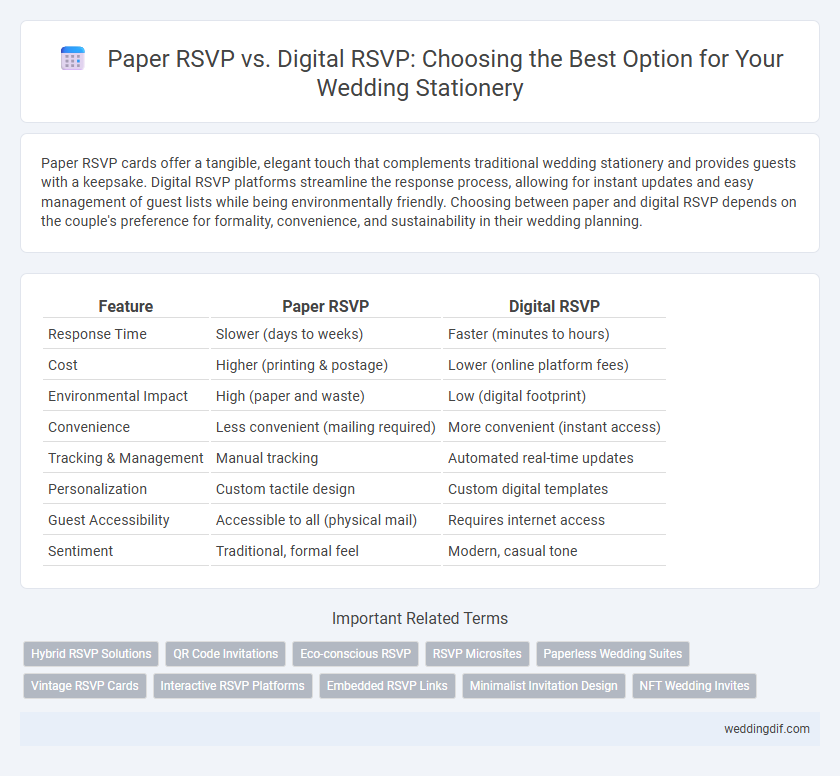Paper RSVP cards offer a tangible, elegant touch that complements traditional wedding stationery and provides guests with a keepsake. Digital RSVP platforms streamline the response process, allowing for instant updates and easy management of guest lists while being environmentally friendly. Choosing between paper and digital RSVP depends on the couple's preference for formality, convenience, and sustainability in their wedding planning.
Table of Comparison
| Feature | Paper RSVP | Digital RSVP |
|---|---|---|
| Response Time | Slower (days to weeks) | Faster (minutes to hours) |
| Cost | Higher (printing & postage) | Lower (online platform fees) |
| Environmental Impact | High (paper and waste) | Low (digital footprint) |
| Convenience | Less convenient (mailing required) | More convenient (instant access) |
| Tracking & Management | Manual tracking | Automated real-time updates |
| Personalization | Custom tactile design | Custom digital templates |
| Guest Accessibility | Accessible to all (physical mail) | Requires internet access |
| Sentiment | Traditional, formal feel | Modern, casual tone |
Introduction to Wedding RSVP Choices
Wedding RSVP choices include traditional paper RSVPs and modern digital RSVPs, each offering unique advantages for event planning. Paper RSVPs provide a tangible, elegant touch that complements classic wedding stationery and often becomes a keepsake for couples. Digital RSVPs streamline guest responses through online platforms, enhancing convenience and real-time tracking for efficient guest management.
What is a Paper RSVP?
A Paper RSVP is a traditional wedding stationery element where guests respond to the invitation by mailing back a physical card. It typically includes options for meal preferences, attendance, and sometimes song requests, providing a tangible keepsake for the couple. This method offers a formal and personal touch, enhancing the overall aesthetic and experience of the wedding invitation suite.
What is a Digital RSVP?
A Digital RSVP is an online response system that allows wedding guests to confirm their attendance via a website or mobile app, streamlining event planning and reducing paper waste. This method offers real-time tracking of guest responses and meal preferences, enhancing organization and communication efficiency. Compared to traditional Paper RSVPs, digital options provide faster feedback and greater convenience for both hosts and invitees.
Pros of Paper RSVP Cards
Paper RSVP cards offer a tangible and elegant touch that enhances the overall wedding stationery experience, providing guests with a keepsake that digital RSVPs cannot replicate. They reduce the risk of technical issues and miscommunications, ensuring reliable and straightforward responses. Additionally, paper RSVPs allow for personalized designs and handwriting that add a unique, memorable charm to the wedding invitation suite.
Cons of Paper RSVP Cards
Paper RSVP cards increase costs due to printing, postage, and return mail expenses, making budgets tighter for wedding stationery. They often result in slower response times compared to digital RSVPs, causing delays in finalizing guest counts. Environmental impact is also significant, as paper RSVP cards contribute to unnecessary waste and deforestation.
Advantages of Digital RSVP
Digital RSVP systems streamline wedding planning by instantly collecting guest responses, reducing the risk of lost or delayed mail. They offer real-time tracking and easy integration with guest lists, enhancing organizational efficiency. Eco-friendly and cost-effective, digital RSVPs eliminate paper waste and postage expenses, supporting sustainable event practices.
Drawbacks of Digital RSVP
Digital RSVP for wedding stationery often faces issues with accessibility, as not all guests may have reliable internet access or be comfortable using online platforms. This can result in lower response rates and increased follow-up efforts from the couple. Furthermore, digital invites lack the tangible, personalized touch that traditional paper RSVP cards provide, potentially diminishing the perceived formality and significance of the wedding event.
Environmental Impact: Paper vs Digital
Paper RSVP cards contribute significantly to deforestation and generate waste that often ends up in landfills, increasing environmental pollution. In contrast, digital RSVP systems reduce paper consumption and carbon footprints by minimizing physical resources and eliminating transportation emissions. Choosing digital RSVPs supports sustainable wedding practices by conserving natural resources and reducing overall environmental impact.
Etiquette Considerations for RSVP Methods
Paper RSVP cards for wedding stationery reflect traditional etiquette, offering a tangible and formal response that honors the couple's request with a physical keepsake. Digital RSVP methods provide convenience and immediacy, appealing to tech-savvy guests while maintaining polite communication through prompt replies. Couples should consider their guest demographics and cultural expectations to choose the RSVP method that best balances respect, accessibility, and practicality.
Which RSVP Option Suits Your Wedding?
Paper RSVP cards offer a tangible, elegant touch that suits traditional or formal weddings, ensuring guests receive a physical keepsake and personal reminder. Digital RSVPs provide convenience and instant tracking, ideal for tech-savvy couples or large weddings seeking efficiency and easy guest management. Consider the wedding style, guest demographics, and budget to determine if the classic charm of paper or the streamlined nature of digital RSVP aligns better with your event needs.
Paper RSVP vs Digital RSVP for wedding stationery. Infographic

 weddingdif.com
weddingdif.com